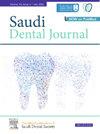A cross-sectional study on dentists’ learning preferences for learning about light-curing units and resin-based composites
IF 2.3
Q3 DENTISTRY, ORAL SURGERY & MEDICINE
引用次数: 0
Abstract
Introduction
Despite researchers emphasizing the importance of understanding the type, how they should be used, and their effect on restoration longevity, many dentists lack critical knowledge about their light curing units (LCUs).
Aim
To identify the parameters dentists use when choosing an LCU or resin-based composite (RBC) and to determine the most effective educational method for dentists to learn about LCUs.
Methods
A cross-sectional study used a validated electronic questionnaire targeting dentists, interns, and students in private and government sectors. Demographic data, current LCU practices, parameters for selecting LCUs and RBCs, and the preferred educational methods for learning about LCUs were collected. The three main parameters used to determine participants’ knowledge of LCU selection were brand reputation, irradiance, and LCU wavelength compatibility with the RBC photoinitiator spectrum. Results were analyzed using chi-square test, Fisher’s exact test, and independent sample t-test.
Results
A total of 420 participants completed the survey. Only 11 % considered the wavelength as the 1st parameter when selecting an LCU. Participants with graduate degrees were significantly more knowledgeable about the LCU selection parameters than those with bachelor’s degrees (p = 0.009). Dentists who frequently used LCUs knew significantly more about the RBC selection parameters (p = 0.037). Hands-on workshops, in-person lectures, and online lectures were preferred over social media. YouTube is one of the most popular social media platforms. All participants preferred YouTube as the top social media educational resource, with specialists and consultants showing a significantly stronger preference than general dentists, interns, and students (p = 0.036).
Conclusion
Few participants thought that the need for the wavelengths emitted by the LCU to be compatible with the absorption spectrum of the photoinitiator used in the RBC was a key parameter when selecting an LCU or RBC. Respondents favored hands-on workshops and in-person lectures over social media to learn about LCUs. Educators should prioritize these methods to enhance understanding the choice and use of LCUs and RBCs within the dental community.
牙医对光固化单元和树脂基复合材料学习偏好的横断面研究
尽管研究人员强调了解光固化单元的类型、如何使用以及它们对修复寿命的影响的重要性,但许多牙医缺乏关于光固化单元(lcu)的关键知识。目的确定牙医在选择LCU或树脂基复合材料(RBC)时使用的参数,并确定牙医学习LCU的最有效的教育方法。方法横断面研究采用有效的电子问卷调查,针对私营和政府部门的牙医、实习生和学生。收集了人口统计数据、当前LCU实践、选择LCU和红细胞的参数以及学习LCU的首选教育方法。用于确定参与者对LCU选择知识的三个主要参数是品牌声誉、辐照度和LCU与RBC光引发剂光谱的波长兼容性。结果采用卡方检验、Fisher精确检验和独立样本t检验进行分析。结果共有420名参与者完成了调查。只有11%的人在选择LCU时将波长作为第一参数。具有研究生学位的参与者对LCU选择参数的了解程度显著高于具有学士学位的参与者(p = 0.009)。经常使用lcu的牙医对RBC选择参数的了解程度显著高于其他牙医(p = 0.037)。与社交媒体相比,实践研讨会、现场讲座和在线讲座更受欢迎。YouTube是最受欢迎的社交媒体平台之一。所有参与者都更喜欢YouTube作为最重要的社交媒体教育资源,专家和咨询师比普通牙医、实习生和学生表现出更强的偏好(p = 0.036)。结论很少有参与者认为,在选择LCU或RBC时,LCU发射的波长与RBC所用光引发剂的吸收光谱是否兼容是一个关键参数。受访者更喜欢实践研讨会和面对面的讲座,而不是社交媒体来了解lcu。教育工作者应优先考虑这些方法,以提高牙科社区对lcu和红细胞的选择和使用的理解。
本文章由计算机程序翻译,如有差异,请以英文原文为准。
求助全文
约1分钟内获得全文
求助全文
来源期刊

Saudi Dental Journal
DENTISTRY, ORAL SURGERY & MEDICINE-
CiteScore
3.60
自引率
0.00%
发文量
86
审稿时长
22 weeks
期刊介绍:
Saudi Dental Journal is an English language, peer-reviewed scholarly publication in the area of dentistry. Saudi Dental Journal publishes original research and reviews on, but not limited to: • dental disease • clinical trials • dental equipment • new and experimental techniques • epidemiology and oral health • restorative dentistry • periodontology • endodontology • prosthodontics • paediatric dentistry • orthodontics and dental education Saudi Dental Journal is the official publication of the Saudi Dental Society and is published by King Saud University in collaboration with Elsevier and is edited by an international group of eminent researchers.
 求助内容:
求助内容: 应助结果提醒方式:
应助结果提醒方式:


